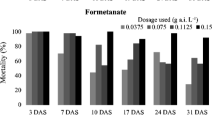Abstract
Chlorpyrifos, formetanate, methamidophos, imidacloprid and endosulfan were tested in the laboratory for their effects upon the mirid bugs Dicyphus tamaninii and Macrolophus caliginosus, which are polyphagous predators used for IPM programs in some vegetable crops. The mortality of third-fourth instar nymphs was checked 24 and 48 hours and 7 days after exposure to 1-, 3-, 8-, 21- and 30-day residues of the treatments on tomato leaflets. The reproductive capacity of surviving females also was evaluated for 15 days and compared with females that had not been exposed to insecticides. Chlorpyrifos, formetanate and methamidophos are considered persistent because they remained toxic to both mirid species for 30 days. Imidacloprid is moderately persistent, becoming harmless by 21 days after treatment for M. caliginosus and by 30 days after treatment for D. tamaninii. Endosulfan is moderately persistent for M. caliginosus, becoming harmless by 21 days after treatment, and is short lived for D. tamaninii, becoming harmless by 3 days after treatment. There were no effects on the reproductive capacity of females that were exposed as nymphs to the insecticides tested. Of all the insecticides, only endosulfan is marginally compatible with the use of D. tamaninii.
Similar content being viewed by others
References
Alomar, O. and R. Albajes, 1996. Greenhouse whitefly (Homoptera: Aleyrodidae) predation and tomato fruit injury by the zoophytophagous predator Dicyphus tamaninii (Heteroptera: Miridae). In: O. Alomar and R.N. Wiedenmann (eds), Zoophytophagous Heteroptera: Implications for life history and IPM. Thomas Say Publications in Entomology, Lanham, Maryland. pp. 89-112.
Barnadas, I., R. Gabarra and R. Alabjes, 1998. Predatory capacity of two mirid bugs preying on Bemisia tabaci. Entomol. Exp. Appl. 86: 215-219.
Boyd, M.L. and D.J. Boethel, 1998. Residual toxicity of selected insecticides to heteropteran predaceous species (Heteroptera: Lygaeidae, Nabidae, Pentatomidae) on soybean. Environ. Entomol. 27(1): 154-160.
Cahill, M., K. Gorman and I. Denholm, 1996. Baseline determination and detection of resistance to imidacloprid in Bemisia tabaci (Homoptera: Aleyrodidae). Bull. Entomol. Res. 86: 343-349.
Castañé, C., J. Ariño and J. Arnó, 1996. Toxicity of some insecticides and acaricides to the predatory bug Dicyphus tamaninii (Het.: Miridae). Entomophaga 41(2): 211-216.
Castañer, M. and A. Garrido, 1995. Toxicidad producida por contacto y persistencia de diversos plaguicidas sobre tres insectos utilizados en control biologico: Cryptolaemus montrouzieri, Lysiphlebus testaceipes y Encarsia formosa. Invest. Agr.: Prod. Prot. Veg. 10(1): 139-147.
De Cock, A., L. De Clercq, L. Tirry and D. Degheele, 1996. Toxicity of diafenthiuron and imidacloprid to the predatory bug Podisus maculiventris (Heteroptera: Pentatomidae). Environ. Entomol. 25(2): 476-480.
Delbeke, F., P. Vercruysse, L. Tirry, P. De Clercq and D. Degheele, 1997. Toxicity of diflubenzuron, pyriproxyfen, imidacloprid and diafenthiuron to the predatory bug Orius laevigatus (Het. Anthocoridae). Entomophaga 42(3): 349-358.
Goula, M., 1986. Contribución al conocimiento de los Hemípteros (Insecta, Heteroptera, Familia Miridae). Ph.D. Thesis, Department of Zoology, University of Barcelona, 1164 pp.
Hassan, S.A., R. Albert, F. Bigler, P. Blaisinger, H. Bogenshütz, E. Boller, J. Brun, P. Chiverton, P. Edwards, W.D. Englert, P. Huang, C. Inglesfield, E. Naton, P.A. Oomen, P.J. Overmeer, W. Riekmann, L. Samsøe-Petersen, A. Stäubli, J.J. Tuset, G. Viggiani and G. Vanwetswinkel, 1987. Results of the third joint pesticide testing progamme by the IOBC/WPRS working group “Pesticides and beneficial organisms”. J. Appl. Entomol. 103: 92-107.
Immaraju J.A., T.D. Paine, J.A. Bethke, K.L. Robb and J.P. Newman, 1992. Western flower thrips (Thysanoptera: Thripidae) resistance to insecticides in coastal California greenhouses. J. Econ. Entomol. 85(1): 9-14.
Mizell III, R.F. and D.E. Schiffhauer, 1990. Effects of pesticides on pecan aphid predators Chrysoperla rufilabris (Neuroptera: Chrysopidae), Hippodamia convergens, Cycloneda sanguinea, Olla v-nigrum (Coleoptera: Coccinellidae), and Aphelinus perpallidus (Hymenoptera: Encyrtidae). J. Econ. Entomol. 83(5): 1806-1812.
Nemoto, H., 1995. Pest management systems for eggplant arthropods: a plant to control pest resurgence resulting from the destruction of natural enemies. JARQ 29: 25-29.
Raj, M.F., P.G. Shah, B.K. Patel and J.R. Patel, 1991. Endosulfan residues in/on tomato and brinjal fruits. Pesticide Res. J. 3(2): 135-138.
Robertson, J.L. and H.K. Preisler, 1992. Pesticide bioassays with arthropods. CRC, Boca Raton, Florida.
SAS Institute, 1989. SAS/STAT user's guide for personal computers, release 6.12 ed. SAS Institute, Cary, NC.
Smilanick, J.M., F.G. Zalom and L.E. Ehler, 1996. Effect of methamidophos on the pentatomid egg parasitoids Trissolcus basalis and T. utahensis (Hymenoptera: Scelionidae). Biological Control 6(2): 193-201.
Theiling, K.M. and B.A. Croft, 1989. Toxicity, selectivity and sublethal effects of pesticides on arthropod natural enemies: A data-base summary. In: P.C. Jepson (ed), Pesticides and non-target invertebrates. Intercept, Andover, UK. pp. 213-232.
van de Veire, M., G. Smagghe and D. Degheele, 1996. Laboratory test method to evaluate the effect of 31 pesticides on the predatory bug, Orius laevigatus (Het.: Anthocoridae). Entomophaga 41(2): 235-243.
Author information
Authors and Affiliations
Corresponding author
Rights and permissions
About this article
Cite this article
Figuls, M., Castañé, C. & Gabarra, R. Residual toxicity of some insecticides on the predatory bugs Dicyphus tamaninii and Macrolophus caliginosus. BioControl 44, 89–98 (1999). https://doi.org/10.1023/A:1009923709456
Issue Date:
DOI: https://doi.org/10.1023/A:1009923709456




